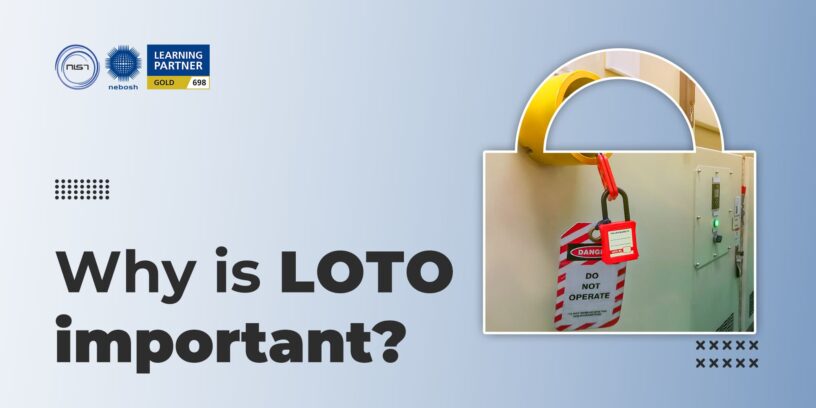What is a safe work environment?
An important part of a safe work environment is to know and enforce the rules for using, operating, servicing, repairing and maintaining all your electrical equipment. Your equipment should be checked regularly to ensure the equipment is safe. Remember, in many accidents, just the presence of the victim in an area of danger was all that was required to cause damage. To be sure your equipment is working correctly, you must operate and maintain the equipment in a safe way.
Safety locking-out tags-out – is a method for preventing damage that can be caused by an un-authorised person entering an area of risk.
This type of lock-out safety system is commonly used in places such as hospitals, factories, and nuclear power plants etc.
What is LOTO (Lock out, Tag out)?
A lockout-tagout (LOTO) means that all the devices that use electricity, such as the HVAC, lighting, and power tools, are to be secured and then switched off. During LOTO, a tag is placed on a component to make sure that the piece of equipment remains in non-working condition until the maintenance is completed. To prevent serious injury, all maintenance operations must be LOTOed. They are “locked and tagged out” so that if there is an issue, the crew will know.
A lockout-tagout (LOTO) procedure is used to ensure that the proper procedures are used during any maintenance activity involving moving machinery. It is important that any repair or maintenance activity involving moving machinery be LOTOed.
In the case of an unsecured switch, it can be opened without notice and lead to electrical fires or injury. When an electric circuit is being worked on, any person who might be exposed to electricity should lock out their own power supply. If the locks are not locked off prior to servicing the system, an electric shock could result and possibly causing injury or death to those exposed to the current from the electrical power source while it is live. If a worker is found to be responsible for the switch’s improper operation, they will be charged with a serious offence under the Occupational Health and Safety Act, and the worker will be fired.
The Objective of LOTO:
The purpose of LOTO is to prevent injuries caused by unsafe working conditions such as exposure to arc flash, electric shock, electrocution, and fire. In short, LOTO aims to minimise any hazards associated with a loss of load condition; and, to provide protection against damage resulting from an accidental electrical short circuit or high voltage event within a distribution system. It is a proven method of safety and prevention for those working in areas of high-risk contamination.
Why is LOTO important?
Preparing for the shutdown is required in certain circumstances, such as when there is insufficient electrical power available to maintain the equipment on line and the plant must be shut down to avoid damage or injury due to an emergency condition (e.g,fire). The shutdown preparation process begins before the actual shutdown of the power source by disconnecting any safety related equipment which may affect the integrity of the power supply (i.e., switchgear) or the equipment being shutdown (i.e., load). After the safety equipment is disconnected from the system, the control system is placed into a “safety mode” where all input signals to the controller are zeroed and the output signals are set at maximum safe levels.
If any of these steps is not carried out correctly, then the entire LOTO process can fail or become hazardous to workers and other people in the immediate area if an equipment failure occurs during the LOTO process.
Listed below are suggested actions to mitigate potential safety risks associated with lock out tag out procedures:
- Verify that power to the equipment in question has been disconnected.
- Verify that the air conditioning is off.
- Verify that the door to the container is shut.
- Verify that the container in which the equipment is housed is not in the process of being emptied or moved.
- Verify that the equipment is not in an unsecured location that could facilitate a person opening the container if they should become unsecured.
- Ensure that the lock out tag out procedures on the container door are in place and properly operated.
- Ensure that the exit/entrance door to the container is secured during the Lock-out, Tag- out Procedure.
- Verify that electrical equipment is not working or otherwise generating an electrical hazard.
- Make sure all equipment is connected to a secure backup battery or battery backup that can be de-energized if the main battery should become inoperable.
- Ensure that all battery connections are properly terminated and secured.
- Verify that the battery is not in an unsecured location.
- Make sure electrical equipment is operating in accordance with the documentation.
- Verify that the electrical equipment being de-energized is in a location which is safe for persons to stand in the area (such as behind an access door).
- Ensure that any persons working on the equipment are wearing appropriate personal protective equipment (PPE) such as electrical gloves, shoes and/or hair covers.
- Ensure that no equipment is located in a confined area.
- Ensure that the equipment is within easy reach of an appropriate supervisor/supervisor’s PPE, when personnel are working on the equipment.
- Ensure that the equipment is within easy reach of the Lock-Out Tag-Out procedures.
LOTO Training covers the following:
- Proper use of a lock out, tag out device
- Recognizing and responding to lockout and tag out signs
- Correcting a lockout situation
- Recognizing a tag out situation
- Avoiding tag out
Importance of (LOTO) training:
LOTO training provides a comprehensive overview of all energy isolation concepts, including the risks and hazards associated with them, procedures required to control these energies, and methods used to detect the occurrence of an energy event so that appropriate action can be taken to avoid personal injuries or damage to property, etc.
This training is intended for personnel responsible for the operation and maintenance of machinery and equipment using energy and who are potentially exposed to this hazard when working on, around, or near equipment having energy storage components such as accumulators, flywheels, or compressed air systems.
It’s a major safety improvement when a facility implements a lockout/tagout procedure to prevent work activities while repairs are being performed on any piece of equipment or machinery that can harm workers in the event of an accident or malfunction, and a failure of this process could result in serious injuries or even death for some people working around hazardous materials or operating dangerous machinery. According to the National Safety Council, accidents at construction sites where power equipment is not properly locked out prior to maintenance or repair work result in more than 300 fatalities each year.
Benefits of LOTO training:
In this course, you will learn and become familiar with,
- How to recognize and identify situations that may lead to accidents involving high voltage electrical circuits
- What actions should be taken when confronted with these situations
- The basic principles of safe work practices in high-voltage environments, including procedures for working safely around machinery and electrical power circuits and devices in general
- Safety requirements for work at heights or near overhead lines, switchgear, transformers and other critical components of an electric power distribution system.
- The proper methods and techniques for handling, measuring, isolating, grounding, and testing electrical wiring systems, conductors, fuses, switches, meters and other related electrical equipment.
Who can undergo this training?
- Assembly line workers
- Construction workers
- Fork lift operators
- Machinists, welders, etc.,
Why NIST?
NIST is an ISO 9001:2015 Certified Training Company for imparting technical and managerial skills to enhance performance through training and development programmes that meet all industry standards. For more than a decade now, NIST has been actively engaged in the training of personnel across industries, including the Oil & Gas sector, Power Sector, and Nuclear Energy Industry, across India. NIST-certified training courses are of high quality, practical, and have a long-lasting impact on learners’ performance. The training is conducted by expert trainers who have specialized in the field and have also been involved in industrial practise for several years before taking up this assignment to impart quality training, which helps them understand their subject better and teach it effectively. Happy Learning!
For further details, contact our client servicing team @ +91 9384663536 or mail us at corporate.sales@nistinstitute.com














Leave a Reply